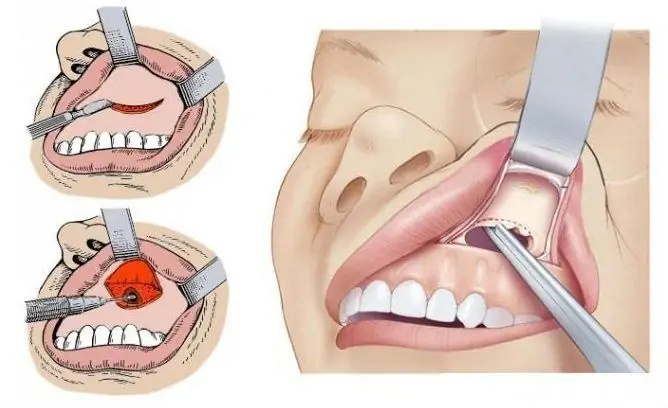- Author Rachel Wainwright [email protected].
- Public 2023-12-15 07:39.
- Last modified 2025-11-02 20:14.
Retention cyst

A retention cyst is a rounded, elevated formation of a pathological nature, which has a transparent or bluish thin membrane with mucous contents. Retention cysts can be acquired or congenital. Acquired retention cysts are formed as a result of the accumulation of secretions, which have a liquid consistency, in the capsule or duct of the secretory organ. Congenital retention cysts occur when, even during the intrauterine development of a child, the walls of the glands are fused together.
These neoplasms can appear at any age and, often, affect elements of the endocrine and exocrine systems. The mechanism of development of the retention cyst: due to blockage of the excretory canal of the gland by a clot of the secretion itself, a foreign body, or when its walls are squeezed by scar tissue or a tumor, the outflow of liquid secretion stops. Due to the accumulation of fluid, the walls of the cavity are gradually stretched, as a result of which cysts of the milk, sebaceous, pancreas, prostate, Bartholin, and other glands develop. This pathological group also includes a corpus luteum cyst and ovarian follicular cysts.
Retention cyst in the cervix
There is a retention cyst in the cervix due to the growth on the cylindrical epithelium, which lines the cervical canal of the squamous stratified epithelium of the vaginal part. Such neoplasms are called cysts of the glandular glands. Inflammatory diseases cause retention cysts in the cervix: cervicitis caused by genital infections, and cervical erosion. When treating retention cysts in the cervix, the intracystic fluid is removed to avoid re-infection, as it may contain infectious pathogens.
Ovarian retention cysts
The symptoms of ovarian retention cysts are:
- Menstrual irregularities. With the development of the disease in adolescents, the onset of the first menstruation is late. In the future, menstruation becomes irregular, oligomenorrhea (a decrease in the duration of menstruation) and hypomenorrhea (a decrease in discharge during menstruation) appear. Sometimes amenorrhea occurs (complete cessation of menstruation);
- Anovulatory infertility. With this type of infertility, pregnancy is possible, but it tends to be interrupted at different stages of development;
- Acne (acne) during adolescence;
- Hair loss or baldness;
- Hirsutism, characterized by increased hair growth on the limbs, face and the area around the nipples;
- Obesity.

Ovarian retention cysts are unbroken follicles with a build-up of fluid that begin to form after ovulation. The retention cysts of the ovaries rupture due to a decrease in the amount of estrogen in the blood, which usually occurs during the next menstruation. Their rupture and, accordingly, the outpouring of the contents into the abdominal cavity leads to tissue irritation and painful sensations.
Treatment of retention cysts
Treatment of retention cysts is mainly surgical. Before removal of retention cysts in the cervix, their size, number and presence of inflammatory relapses (cervicitis, colpitis (vaginitis), adnexitis) are taken into account. Removal of retention cysts is carried out only after the complete elimination of inflammatory processes and sexually transmitted pathogens. Such procedures contribute to the disappearance of the retention cyst, and also significantly reduce the risk of complications (large-scale inflammatory processes in the small pelvis). Retention cysts are removed using diathermocoagulation, cryo- and laser destruction methods.
Treatment for ovarian retention cysts consists of pain relievers, hormone therapy, and oral contraceptives.
YouTube video related to the article:
The information is generalized and provided for informational purposes only. At the first sign of illness, see your doctor. Self-medication is hazardous to health!






